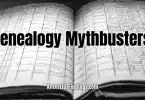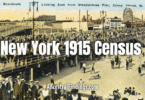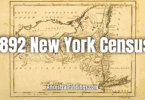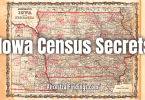The 1840 U.S. Census might be early American recordkeeping’s most overlooked turning point. It still looks like the older ones—just one name listed, a page full of tick marks, and plenty of room for guesswork. But this was a census taken on the edge of transformation. The United States was about to change fast. Railroads were spreading. The telegraph was just a few years away. Families were scattering across the continent. And yet, there was still one more census to be taken the old way—by head of household, with ages in neat little boxes.
If you’re working with ancestors in the 1840s, this census may be the last breadcrumb before the trail suddenly gets clearer in 1850. But even though the names are still missing for most people, the 1840 census hides some of the best leads in early American research—especially if you take your time with it.
What Was New in 1840?
Compared to the 1830 census, the 1840 census made a few small but meaningful changes. First, the age categories were expanded, especially at the top end. The census now included separate columns for people aged 80 to 89, 90 to 99, and 100 and over. That doesn’t sound dramatic, but it matters. If you’ve got an ancestor born in the 1740s or earlier—someone who lived long enough to see railroads, steamships, and a country growing beyond the Mississippi—this might be the census where they last appear. And for those of us trying to pin down birth years or confirm whether someone was still alive in the early 1840s, those age brackets are a quiet gift.
Another change was the count of persons with disabilities, including those who were blind, deaf, or mentally ill. It’s one of the earliest times the government tried to track this part of the population, and while it was far from perfect, it gives researchers a rare insight into households that were caring for family members with lifelong challenges. If you’ve ever found a puzzling gap in a family’s story—someone who stayed home, never married, or disappeared from other records—this census can sometimes help explain why.
But perhaps the biggest change was the inclusion of a separate schedule of Revolutionary War pensioners—a rare moment when the government actually named people outside the usual head-of-household format.
The Revolutionary War Pensioner Schedule
This part of the 1840 census is a goldmine. Each county was supposed to submit a list of every person in the area who was receiving a pension for service in the American Revolution. These were actual names—men (and occasionally widows) who had either fought in the war or were surviving spouses of those who did.
What makes this so useful is that it links pensioners to the households where they were living. You might find an elderly veteran living with his son or daughter, or with a neighbor acting as caregiver. Suddenly, you’re not just guessing whether someone was still alive—you’ve got a name, an exact location, and sometimes even notes about their age or condition.
These schedules are filed separately from the main census rolls, but they were published and are widely available. Many can be found in printed form or in digital archives like HathiTrust, Internet Archive, or Fold3. I’ve used this list more than once to confirm a hunch that an older man living with a younger couple was the family patriarch. And I’ve seen it spark discoveries about previously unknown Revolutionary War service, especially for men whose military records are thin or missing.
Clues in the Age Brackets
Like in 1830, the 1840 census gives you age groups for every member of the household, both male and female, including enslaved individuals and free people of color. But by now, the groupings are more detailed, especially for older adults.
This helps when trying to untangle families with common names. If there are two John Smiths in the same area, but one is in the 40–49 bracket and the other is 50–59, and one has older children still at home, that starts to narrow things down. If you’re lucky, you’ll see aging parents living with grown children, or unmarried siblings sharing a home. The layout hasn’t changed much since 1830, but there’s more precision tucked into those boxes.
It’s also worth paying attention to the younger age groups, especially for tracking children born in the 1830s. Since these kids won’t show up by name until the 1850 census, this earlier entry might be the only confirmation of their existence. If a child disappears between 1840 and 1850, that could point to an early death, or a marriage, apprenticeship, or move to live with other relatives. Either way, this is your best shot at anchoring their place in the household.
Work and Education
One overlooked part of the 1840 census is the section that records how many people were employed in certain types of work. It asks whether anyone in the household worked in agriculture, commerce, or manufacturing. If you see a household with several males listed as employed in manufacturing, that tells you something about what kind of life they were living, especially in areas near mills, rivers, or growing towns.
The census also asked about schools and literacy, although this wasn’t always detailed at the household level. Still, if someone in the home was a teacher or operated a school, it might be noted. And in some cases, counties submitted additional schedules showing how many children attended school or how many schools existed in a township. If you’re studying a town or tracing a family known for education, this might offer a clue about their role in the community.
Genealogy Tips from the 1840 Census
Here’s how I usually work with the 1840 census in my own research. First, I use the age brackets to build out likely family groups, trying to match parents and children based on ages and household size. Then I cross-check that with the 1830 census. Did the number of children change? Did older parents move in or disappear?
Next, I look for patterns in neighbors. Who’s living nearby? Are there other households with the same surname, or familiar names from earlier records? Families often moved together or settled near one another, and that can help confirm connections.
I also compare the 1840 listings with known veterans from the Revolutionary War pension files. If I’ve already found a pension file, I check to see if the veteran is listed in the 1840 pensioner schedule. If they’re not, but they were alive in 1832, I start asking why. Did they die just before the census? Did they move in with a different relative in another county?
Finally, I use the employment categories and disability notations to help round out the story. If a household includes someone marked as blind or deaf, or someone working in manufacturing while most of the town was farming, that can point me toward newspapers, court records, or town directories that fill in the details.
My Final Thoughts
The 1840 census is more than just a last glimpse before the names appear. It’s a mirror of a country on the brink of major change—politically, socially, and technologically. It still asks its questions in an old-fashioned way, but the answers are deeper, the clues sharper, and the stories closer to the surface.
When you sit down with the 1840 census, you’re looking at a snapshot of a generation that lived through revolution, expansion, and unrest. You’re catching one last look at grandparents, aging patriots, and growing families before the historical lights turn on in 1850. It’s worth taking your time with it. Because in those quiet pages, a lot of voices are still waiting to be heard.






